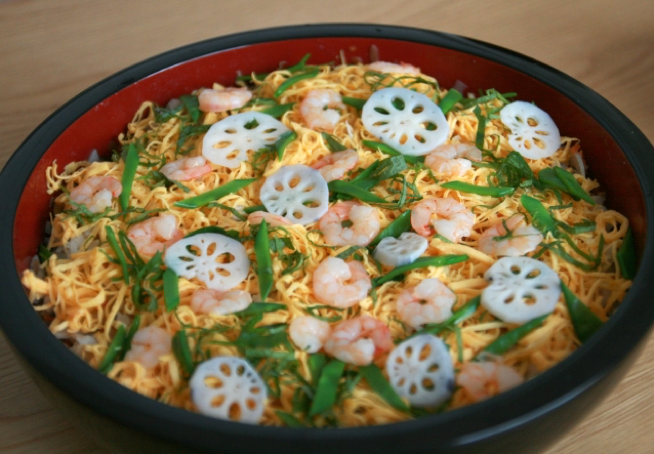
The History of Hinamatsuri
Hinamatsuri is the Japanese holiday “Girls’ Day” and is also sometimes known as the Doll’s Festival. This is a special day the Japanese celebrate every year on March third (Yoshizuka, 2019). Originally this holiday was one of the five seasonal holidays when Japan used the Chinese calendar and the holidays would occur on the first day of the first month, third day of the third month, fifth day of the fifth month, and so on (Wikipedia, n.d.). The original festival was called the Peach Festival and celebrated the blooming of the peach trees and once the calendar was shifted to the Gregorian calendar this was no longer the case and the holiday became known as Girls’ Day (Wikipedia, n.d.).
The celebration of Girls’ Day is held to pray for the happiness and the health of young girls in Japan (Yoshizuka, 2019). In homes with young girls, a tiered display will be set up with dolls that have been purchased, or passed down from older generations (Savory Japan, n.d.). The dolls represent the Emperor, Empress, and in wealthier families, maids in waiting, court musicians, and so on (Savory Japan, n.d.). These dolls are seen to look over young girls and guard their health and happiness while warding off bad luck and misfortune (Savory Japan, n.d.).
Food of Hinamatsuri
During Hinamatsuri young girls will have parties with their friends and spend time with their families (Yoshizuka, 2019). There are six standard foods that are traditional to include in the celebrations. Although there seem to be no specific taboos with this celebration, the emphasis is on family. Meals tend to be prepared in bento box form and made ahead of time so there is minimal time spent away from the family cooking. The common foods during this celebration are hishimochi, shirozake, hina arare, ushiojiru, chirashi-zushi, and chichi dango.
Hishimochi
Hishimochi are diamond shaped cakes and are usually placed on tiers with the dolls (Yoshizuka, 2019). They most commonly have three layers, pink, white and green, but sometimes can have up to seven layers (Wikipedia, n.d.). In some areas yellow will take the place of pink (Wikipedia, n.d.). The shape may have originated in the Edo period and is believed to represent fertility (Wikipedia, n.d.). The pink colour symbolizes plum blossoms, green the fresh new growth of spring and white represents the last snow of winter (Savory Japan, n.d.).

Shirozake
Shirozake is a white fermented rice wine (Yoshizuka, 2019), is the first type of sake of the year, and is available in early spring (Savory Japan, n.d.). The sake is white, sweet and unfiltered. Even though women did not drink in the old days it became associated with girls (Savory Japan, n.d.). This drink is a symbol of purity and health for young girls and with this drink parents and grandparents will toast to the health of their daughters (Pretty in Pink, 2018).

Hina Arare
Hina Arare are small balls of crunchy puffed rice, sometimes sweetened with sugar, and can be shaped like a blossom or snowflake (Savory Japan, n.d.). They come in white, pink and green and the colours represent the same as the hishimochi. Tradition from the old days was to make the arare from the leftover mochi from the New Year’s (Oshogatsu) festival and because this was an effective use of leftovers it became symbolic of the desired qualities of a wife (Savory Japan, n.d.).

Ushiojiru
Ushiojiru is a clam soup served in the clam shell. The soup being served in the joined, open, clamshell is symbolic of a joined pair (Pretty in Pink, 2018). This joined pair symbolizes a happy marriage for the young girl (Pretty in Pink, 2018).

Chirashi-zushi
Chirashi-zushi is also known as “scattered sushi” (Pretty in Pink, 2018). There is a variety of raw fish and vegetables served on a bed of sushi rice, in a bowl or bento box, that is sweetened and vinegary (Wikipedia, n.d.). It is common during the festival because of how filling it is and the speed and ease with which it can be made (Wikipedia, n.d.).

Chichi dango
Chichi dango is a common sweet that is served during the Girls’ Day festival (Pretty in Pink, 2018). They are usually made in feminine colours, such as pink, and are a favourite with children (Pretty in Pink, 2018). Chichi dango is made of a mochi, a glutinous rice flour with coconut milk, and formed into little pillow shapes (Pretty in Pink, 2018).
After the Festival
Celebrations usually start at the end of February with dolls being set out on their tiered display (Yoshizuka, 2019). The main celebration occurs on March third and the next day all of the decorations are promptly removed. Keeping the dolls up any longer is seen to be bad luck and means the family will having trouble with finding a marriage for their daughters (Yoshizuka, 2019). A family will usually stop celebrating Girls’ Day with the doll display sometime around the time their daughter reaches the age of around ten (Wikipedia, n.d.).
References
[Chirashi-zushi] retrieved from https://guidable.co/culture/5-hinamatsuri-foods-that-bring-good-luck/
[Hina Arare] retrieved from https://www.savoryjapan.com/learn/culture/festivals/hinamatsuri.html
[Hinamatsuri] retrieved from https://www.japanissimoviaggi.com/blog/2016/03/625.html
Hina Matsuri (Girls’ Day Festival)(n.d.). Retrieved from https://www.savoryjapan.com/learn/culture/festivals/hinamatsuri.html
Pretty in Pink: The Foods of Hina Matsuri(2018). Retrieved from https://guide.michelin.com/sg/dining-out/pretty-in-pink-the-foods-of-hina-matsuri/news
[Shirozake] retrieved from https://guidable.co/culture/5-hinamatsuri-foods-that-bring-good-luck/
[Ushiojiru] retrieved from https://guidable.co/culture/5-hinamatsuri-foods-that-bring-good-luck/
Wikipedia. (n.d.). Hinamatsuri. Retrieved from https://en.wikipedia.org/wiki/Hinamatsuri
Yoshizuka, S. (2019). Japanese Girls’ Day or Hinamatsuri?Retrieved from https://www.thespruceeats.com/hina-matsuri-2031037
